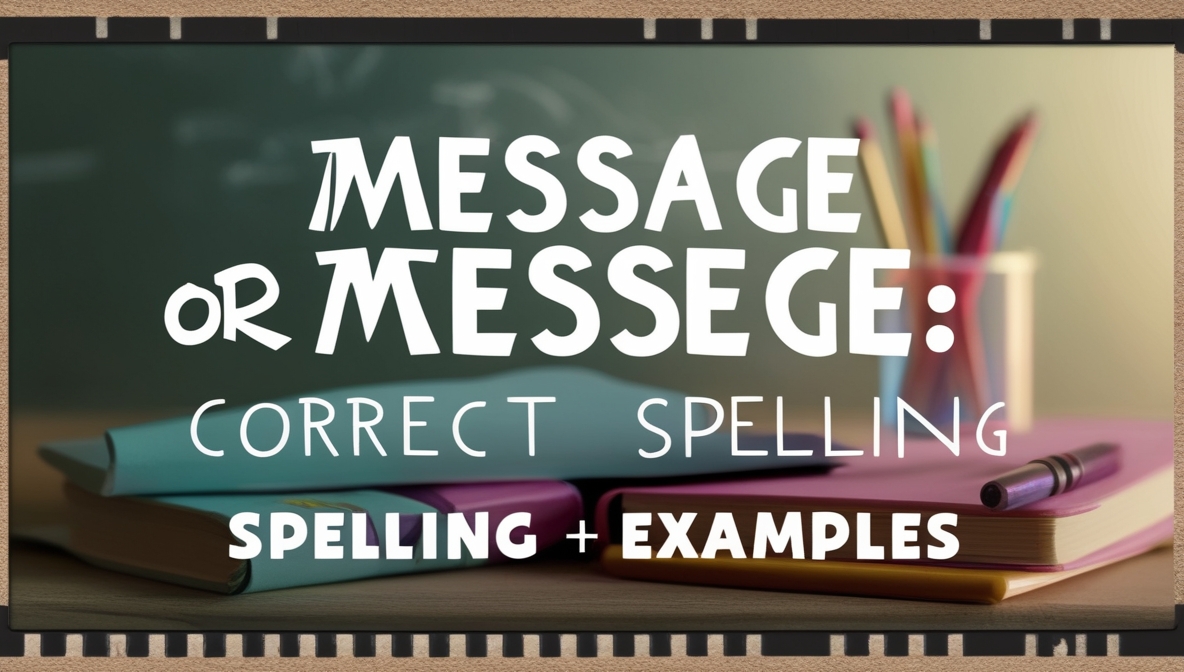In the realm of English language nuances, few pairs of words create as much confusion as “message” and “messege.” The latter is a common misspelling, but understanding the correct usage of “message” is essential for clear communication. This article will delve into the correct spelling, meanings, examples, and scenarios that illustrate the importance of using “message” properly.
Understanding the Correct Spelling: Message
The correct spelling is “message.” It derives from the Old French word “mésage,” which in turn comes from the Latin “missaticum,” meaning “a sending.” In its essence, a message is something that is sent or communicated, often conveying information, thoughts, or feelings from one person to another.
The Definition of Message
A message can take various forms, including verbal communication, written notes, digital texts, and even non-verbal cues like gestures or body language. The key component is that a message is intended to convey meaning.
Common Uses of “Message”
To illustrate the correct use of “message,” let’s explore various scenarios:
1. Written Communication
Imagine you receive an email from your boss with the subject line “Important Message.” In this context, the term “message” refers to the content of the email, which likely contains significant information regarding a project update or a company policy change.
Example:
I received an important message from my manager about the upcoming deadline.
2. Text Messaging
In today’s digital age, text messaging has become a primary mode of communication. When you send a quick note to a friend asking how they are, you are sending a message.
Example:
I just sent a message to Sarah asking if she wants to grab dinner later.
3. Verbal Communication
When people engage in conversations, they often exchange messages through spoken words. Consider a situation where you ask your colleague for their opinion on a presentation. The response you receive is a message reflecting their thoughts.
Example:
During the meeting, John delivered a clear message about the project’s direction.
4. Non-Verbal Communication
Sometimes, messages are conveyed without words. For instance, a smile can send a positive message, while crossed arms might convey defensiveness.
Example:
Her smile was a message of encouragement, reassuring me that I was doing well.
Why “Messege” is Incorrect
The misspelling “messege” is not recognized in the English language. It is a common error that arises from phonetic spelling tendencies. Many people confuse the letters in the word, but understanding the correct spelling is crucial for effective communication. Using incorrect spellings can lead to misunderstandings and may undermine your credibility in professional settings.
The Importance of Correct Spelling
Correct spelling is essential for several reasons:
- Clarity: Using the correct spelling of “message” ensures that your communication is clear and easily understood.
- Professionalism: Proper spelling conveys a sense of professionalism and attention to detail, which is especially important in business environments.
- Avoiding Confusion: Miscommunication can lead to significant issues, particularly in critical situations. Proper spelling helps prevent confusion.
Synonyms and Related Terms
To further enrich your understanding, it is helpful to know some synonyms and related terms to “message”:
- Notification: An alert or announcement, often used in digital contexts.
- Communication: The act of conveying information, which can include messages of all kinds.
- Note: A brief written message, usually informal.
Example of Synonyms in Use
- I received a notification from the app about an important update.
- Effective communication is essential for teamwork.
- She left a quick note on my desk to remind me of the meeting.
Scenarios Highlighting the Importance of “Message”
Scenario 1: Business Communication
In a corporate setting, clarity in messaging is vital. Imagine you send a message to your team about a change in the project timeline. If you misspell “message” in a formal email, it could lead to confusion about the urgency and importance of the information.
Example:
Subject: Project Timeline Update
Dear Team, I want to emphasize the importance of this message regarding our project deadlines…
Scenario 2: Social Media Interaction
In the age of social media, crafting the right message is crucial. Suppose you post an update about an event, and someone misinterprets your post due to a spelling error. Using “messege” instead of “message” could lead followers to question the validity of your post.
Example:
I posted a message about our charity event on Facebook, but someone commented with a typo.
Scenario 3: Personal Relationships
In personal relationships, the messages we send can significantly impact our connections. A heartfelt message can strengthen bonds, while a poorly worded message can create misunderstandings.
Example:
I sent her a message expressing my feelings, hoping it would clarify my intentions.
Tips for Avoiding Common Spelling Mistakes
To prevent misspelling “message” and other common words, consider the following tips:
- Practice Regularly: Engage in writing exercises to reinforce word spelling.
- Use Spell Check: Most digital platforms have built-in spell check features that can help identify errors.
- Read Aloud: Sometimes, hearing the words can help you recognize when something feels off.
- Flashcards: Create flashcards for frequently misspelled words, including “message,” to enhance memory retention.
Conclusion
Understanding the correct spelling and usage of “message” is crucial in both personal and professional contexts. By recognizing its importance and avoiding the common misspelling of “messege,” you can ensure that your communication remains clear and effective. Remember, every message you send carries meaning and significance, so make sure it’s conveyed accurately.
In the world of communication, getting the details right can make all the difference. Whether through written, verbal, or non-verbal means, every message matters.

